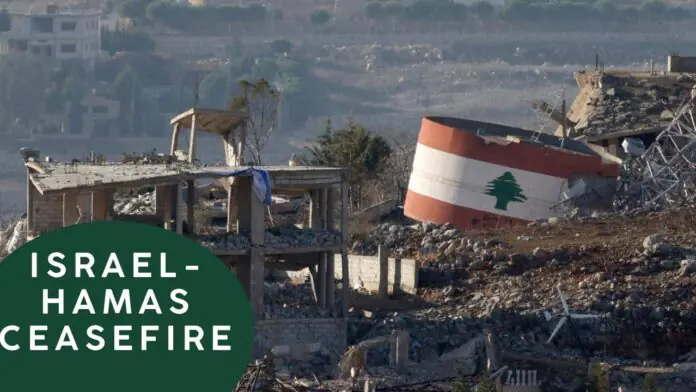Introduction
Israel-Hamas Ceasefire agreement has been established and now one of the most devastating conflicts of the 21st century which lasted for 15 months and claimed thousands of lives seems to have found middle ground. The deal, facilitated by Qatar, Egypt, and the U.S., outlines a plan comprising of three phases which aim to fundamentally eradicate violence, make provisions for the exchange of hostages and prisoners, and commence the rebuilding of Gaza. Nonetheless, this ceasefire raises prime concerns regarding its sustainability, political dynamics involved, and the possibility of long-lasting peace in the region.
The Ceasefire Deal: A Three-Phase Roadmap
The ceasefire agreement refers to the period from January 19, 2025 to March 5th 2025 as it is believed that within this time frame there will be no violence reported. It is created in such a way that it is impossible to go back to violence and has been divided into three segments of approximately 6 weeks each. The first phase deals with fighting and suffering caused by the hostages Israel is holding. In this phase, it is expected that Hamas will release 33 hostages which includes women, children, each elderly as a negotiable bargain for the thousand Palestinian prisoners. It is also forecasted that the aid will jump to 600 trucks which will bring much-needed relief for Gaza’s suffering population.
During the second phase of the ceasefire agreement, which has been detailed as set to occur on the 16th day of the first stage, there is hope to finalise negotiations for total withdrawal of Israeli forces as well as to instate a permanent ceasefire.
The international organs are expected to supervise the reconstruction of Gaza and the recovery of the rest of the hostages in the third phase.
The plan includes an approach to the deal that looks appealing; however, it needs to be complemented with political and logistical developments.
Risks and Challenges: Obstacles and Defusal Mechanisms
Regional and Israeli players can take advantage of the ceasefire which still is at risk of being exploited. Moderates in Israel dominating Prime Minister Benjamin Netanyahu’s coalition have branded the deal as a “catastrophe” and thus, oppose it vehemently. The far-right factions of Israel including the Religious Zionist party of Finance Minister Bezalel Smotrich have also branded the deal as a “catastrophe” for Israel. They advocate a policy of zero tolerance against Hamas and thus, have threatened to withdraw from the coalition government if the ceasefire continues.
The Iran-proxy Hezbollah in Lebanon and the Houthis in Yemen are on the back foot and thus have shifted their stance continuously. Even though these groups have feebly suffered, their stance of showing military support and halting all activities bolsters how frail the ceasefire remains.
A distinct yet essential context lies in the dictatorial stance of Israel to keep a dominant security posture in Gaza along the Philadelphi corridor. This position can be disastrous and worsen the relationship. The rest of the world would also shun away from Hamas if they continue to refuse the Israeli proposal.
Humanitarian Aid and Reconstruction: Never Ending Conflict
Each stage of the conflict ceasefire has its own challenges and the third phase, which is the reconstruction of Gaza, carries some of the most daunting challenges. According to estimates, more than fifty million tonnes of rubble must be cleared along with the unnecessary structures that are estimated to be almost seventy per cent of Gaza, and if left unattended, the rubble can take more than three hundred and fifty years to clear.
Despite the clear desire from Israel and the United States to restrain Hamas from any governance roles, its existence within Gaza makes the situation even more dire. In an instance where there is a Hamas regime, the likelihood of international support becomes scarce since no sane investor would fund a Hamas-ruled territory.
The Human Cost: Struggles and Healing
The landmark peace covenant which was signed recently provides Gaza’s 2.3 million population with the opportunity to breathe with relief and optimism towards the future. Although there is a stark divide amongst the population, with a reasonable number of members thankful to be receiving a chance at peace, a majority of them are afraid at the prospect of returning to homes that are beyond recognition. The level of shocking trauma and psychological damage suffered by people due to constant displacement and bombardment is unfathomable.
In Israel, the other side of the coin highlights families of hostages having cautious optimism and relief due to the newly proposed peace deal, but hoping that important individuals may not all return captured safely.
It is easy to see just how deeply Israeli civilians have been impacted emotionally by the conflict, as many are still coping with the physical as well as emotional scars left by the war and the death of their loved ones.
Still Some Distance To Cover
The ceasefire, albeit a positive start, poses a problem in itself as it has the potential of prolonging the conflict instead of solving it. The primary problem, which is the sovereignty and statehood of Palestinians, has still been left untouched. However, one cannot deny the fact that the involvement of world powers is essential when it comes to the maintenance of global peace. Yet history tells us that these tasks are not simple.
This temporary ceasefire might give the public a feeling that the suffering has come to an end, but in reality, this is not the case. Much like everything else, there is always a backstory to every ceasefire agreement that many are not ready for. The sadness that has engulfed the Middle East will end one day, but when that day arrives requires selfless collaboration and commitment from everyone towards changing the primary factors of the conflict.


